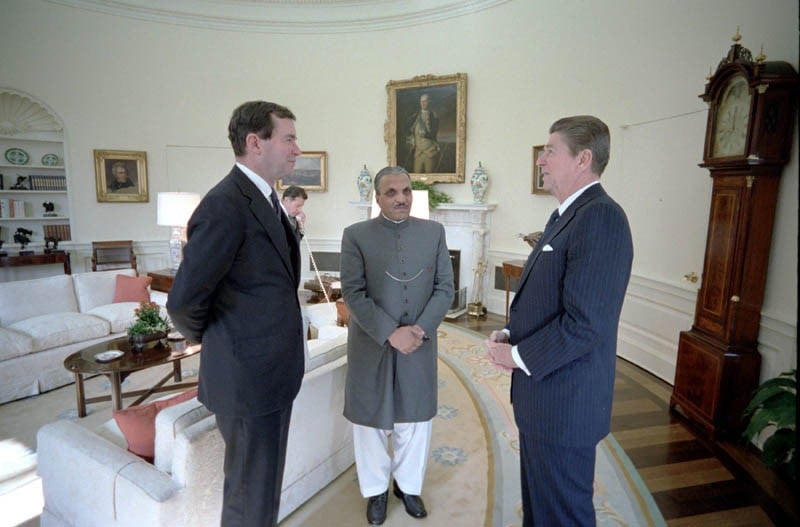
Looking back at the eventful history of US-Pakistan relations

Pakistan, in its initial years, had the option of initiating ties with either the Soviet Union or the United States. Pakistan opted for the latter. Liaquat Ali Khan, Pakistan’s first prime minister, visited the United States in May 1950. That first visit set the tone of the relations between the two countries and Pakistan’s preference for the US in a bi-polar world.
Later, Pakistan signed the Mutual Defence Assistance Agreement with the United States in 1954. Under the agreement, many Pakistani military personnel went to United States for training whereas US also established a Military Assistance Advisory Group (Maag) in Rawalpindi.
US President Dwight Eisenhower requested Pakistan’s Prime Minister Huseyn Shaheed Suhrawardy in 1956 to allow American army for keeping the Soviet Union and its ballistic missile programme under check from the Peshawar airbase. The request was granted.
During much of the 1960s, the US military and financial assistance was directed towards West Pakistan. President Ayub Khan allowed the United States to fly spy mission to Soviet Union from Pakistan’s territory. He paid a visit to United States in 1961.
The US supported Pakistan during the 1970s for being an important ally during the Cold War. Pakistan also played an important role for President Richard Nixon in paying his first ever visit to the People’s Republic of China. Relations between the two countries became tense after the US presidential elections of 1976 in which Jimmy Carter had won. Carter did not seem to like policies of Pakistan’s Prime Minister Zulfikar Ali Bhutto, especially his nuclear ambitions. Bhutto did not agree with the US stance on Pakistan’s nuclear weapons which led to his differences with the US administration.
Understandably, during Ziaul Haq’s regime in the late 1970s and much of the 80s, Pakistan and United States enjoyed a good relationship, which was primarily based on military ties, requiring Pakistan to fight as the frontline state in the war against the Soviet Union. The US gave billions of dollars to Pakistan in the name of military and economic aid during the 1980s. By the year 1987, Pakistan is believed to have become the second largest recipient of US aid after Israel.
After the end of General Zia’s regime, the US Congress adopted the Pressler Amendment in August 1985, which banned major military and economical aid to Pakistan, unless the state was able to provide sufficient evidence that the aid was not being used for nuclear proliferation. US imposed sanctions on Pakistan in 1990 under the Pressler Amendment.
Diplomatic ties between US and Pakistan were affected when the US ambassador Nicholas Platt warned Pakistan in 1992 of being included into a list of state sponsors of terrorism if it continued to support militants causing trouble in India. Relations improved a little when Pakistan’s Prime Minister Benazir Bhutto visited the US in 1995 and requested US President Bill Clinton to lift economic and military embargoes on Pakistan and launch a joint operation to eradicate militancy from the region. That led to the Brown Amendment, which provided for the delivery of $368 million worth of military equipment.
Relations between the two countries again went through a rough patch when in May 1998 Pakistan conducted nuclear tests in Balochistan, in response to similar tests conducted by India. US President Bill Clinton imposed sanctions under the Glenn Amendment on both Pakistan and India. Glenn Amendment meant suspension of aid, including economic development assistance, credits and credit guarantees by the US government, US bank loans to the governments of Pakistan and India, loans from the World Bank and IMF, etc. In July of 1998, however, the US lifted sanctions on both the countries.
The 9/11 terrorist attacks in 2001 on the Twin Towers in the US changed the world equation drastically. Pakistan became one of the most important strategic allies of United States. The US army used its military bases in Pakistan for launching attacks inside Afghanistan. President Pervez Musharraf later disclosed that Pakistan had no other option but to support the US. The superpower had threatened Pakistan of ‘bombing into the Stone Age if it did not join the fight against al-Qaeda.’ Later, President George Bush officially declared Pakistan as a non-Nato ally in 2004, allowing it to purchase strategic and advanced military equipments.
Since then, the US army has launched many drone strikes in the north-western side of Pakistan. That enabled the US to hit big terrorist targets but annoyed Pakistan for violating its sovereignty. With reference to the Taliban, the US accused Pakistan military of running with the hare and hunting with the hound, thus the trust deficit.
In 2009, to top it all, President Musharraf reportedly said that billions of dollars in aid that Pakistan received from the US as a partner in the war against terror were diverted to build better defence against India. It was only vindicating a perception in the US that Pakistan was misusing the funds meant for the war on terror.
Consequently, Kerry-Lugar Bill was signed into a law in October 2009 by the US President Barack Obama. The bill was aimed at granting $7.5 billion of non-military aid. The bill clearly showed US’s distrust in Pakistan’s military.
And then came the bombshell in May 2011. Osama bin Laden was found and killed in Abbottabad in an operation conducted by US Navy Seals in Pakistan. President Barack Obama claimed that the information pertaining to the operation conducted in Abbottabad was not shared with the Pakistan army, which says a lot.
Fast forward to the present day; one of the main al Qaeda leaders, Mulla Akhtar Mansoor, is killed in a US drone strike in Balochistan on May 22, 2016. Of course, the US is not happy to have found him in an ally country, nor is Pakistan.